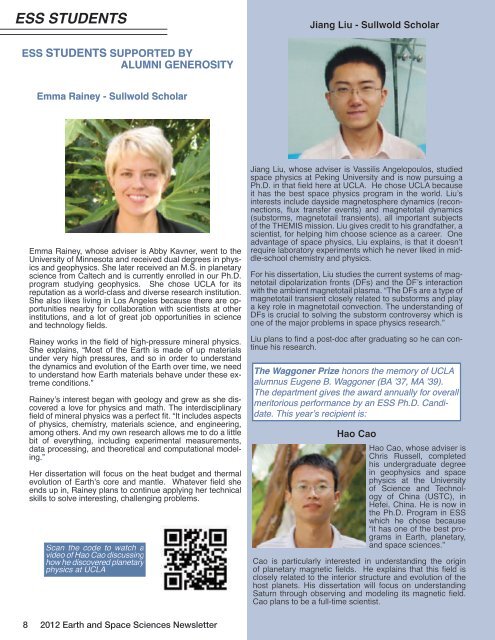2012 Alumni Newsletter (PDF) - Department of Earth and Space ...
2012 Alumni Newsletter (PDF) - Department of Earth and Space ...
2012 Alumni Newsletter (PDF) - Department of Earth and Space ...
Create successful ePaper yourself
Turn your PDF publications into a flip-book with our unique Google optimized e-Paper software.
ESS STUDENTS<br />
ESS STUDENTS SUPPORTED BY<br />
ALUMNI GENEROSITY<br />
Emma Rainey - Sullwold Scholar<br />
Emma Rainey, whose adviser is Abby Kavner, went to the<br />
University <strong>of</strong> Minnesota <strong>and</strong> received dual degrees in physics<br />
<strong>and</strong> geophysics. She later received an M.S. in planetary<br />
science from Caltech <strong>and</strong> is currently enrolled in our Ph.D.<br />
program studying geophysics. She chose UCLA for its<br />
reputation as a world-class <strong>and</strong> diverse research institution.<br />
She also likes living in Los Angeles because there are opportunities<br />
nearby for collaboration with scientists at other<br />
institutions, <strong>and</strong> a lot <strong>of</strong> great job opportunities in science<br />
<strong>and</strong> technology fields.<br />
Rainey works in the field <strong>of</strong> high-pressure mineral physics.<br />
She explains, “Most <strong>of</strong> the <strong>Earth</strong> is made <strong>of</strong> up materials<br />
under very high pressures, <strong>and</strong> so in order to underst<strong>and</strong><br />
the dynamics <strong>and</strong> evolution <strong>of</strong> the <strong>Earth</strong> over time, we need<br />
to underst<strong>and</strong> how <strong>Earth</strong> materials behave under these extreme<br />
conditions.”<br />
Rainey’s interest began with geology <strong>and</strong> grew as she discovered<br />
a love for physics <strong>and</strong> math. The interdisciplinary<br />
field <strong>of</strong> mineral physics was a perfect fit. “It includes aspects<br />
<strong>of</strong> physics, chemistry, materials science, <strong>and</strong> engineering,<br />
among others. And my own research allows me to do a little<br />
bit <strong>of</strong> everything, including experimental measurements,<br />
data processing, <strong>and</strong> theoretical <strong>and</strong> computational modeling.”<br />
Her dissertation will focus on the heat budget <strong>and</strong> thermal<br />
evolution <strong>of</strong> <strong>Earth</strong>’s core <strong>and</strong> mantle. Whatever field she<br />
ends up in, Rainey plans to continue applying her technical<br />
skills to solve interesting, challenging problems.<br />
Scan the code to watch a<br />
video <strong>of</strong> Hao Cao discussing<br />
how he discovered planetary<br />
physics at UCLA<br />
8 <strong>2012</strong> <strong>Earth</strong> <strong>and</strong> <strong>Space</strong> Sciences <strong>Newsletter</strong><br />
Jiang Liu - Sullwold Scholar<br />
Jiang Liu, whose adviser is Vassilis Angelopoulos, studied<br />
space physics at Peking University <strong>and</strong> is now pursuing a<br />
Ph.D. in that field here at UCLA. He chose UCLA because<br />
it has the best space physics program in the world. Liu’s<br />
interests include dayside magnetosphere dynamics (reconnections,<br />
flux transfer events) <strong>and</strong> magnetotail dynamics<br />
(substorms, magnetotail transients), all important subjects<br />
<strong>of</strong> the THEMIS mission . Liu gives credit to his gr<strong>and</strong>father, a<br />
scientist, for helping him choose science as a career. One<br />
advantage <strong>of</strong> space physics, Liu explains, is that it doesn’t<br />
require laboratory experiments which he never liked in middle-school<br />
chemistry <strong>and</strong> physics.<br />
For his dissertation, Liu studies the current systems <strong>of</strong> magnetotail<br />
dipolarization fronts (DFs) <strong>and</strong> the DF’s interaction<br />
with the ambient magnetotail plasma. “The DFs are a type <strong>of</strong><br />
magnetotail transient closely related to substorms <strong>and</strong> play<br />
a key role in magnetotail convection. The underst<strong>and</strong>ing <strong>of</strong><br />
DFs is crucial to solving the substorm controversy which is<br />
one <strong>of</strong> the major problems in space physics research.”<br />
Liu plans to find a post-doc after graduating so he can continue<br />
his research.<br />
The Waggoner Prize honors the memory <strong>of</strong> UCLA<br />
alumnus Eugene B. Waggoner (BA ’37, MA ’39).<br />
The department gives the award annually for overall<br />
meritorious performance by an ESS Ph.D. C<strong>and</strong>idate.<br />
This year’s recipient is:<br />
Hao Cao<br />
Hao Cao, whose adviser is<br />
Chris Russell, completed<br />
his undergraduate degree<br />
in geophysics <strong>and</strong> space<br />
physics at the University<br />
<strong>of</strong> Science <strong>and</strong> Technology<br />
<strong>of</strong> China (USTC), in<br />
Hefei, China. He is now in<br />
the Ph.D. Program in ESS<br />
which he chose because<br />
“it has one <strong>of</strong> the best programs<br />
in <strong>Earth</strong>, planetary,<br />
<strong>and</strong> space sciences.”<br />
Cao is particularly interested in underst<strong>and</strong>ing the origin<br />
<strong>of</strong> planetary magnetic fields. He explains that this field is<br />
closely related to the interior structure <strong>and</strong> evolution <strong>of</strong> the<br />
host planets. His dissertation will focus on underst<strong>and</strong>ing<br />
Saturn through observing <strong>and</strong> modeling its magnetic field.<br />
Cao plans to be a full-time scientist.


